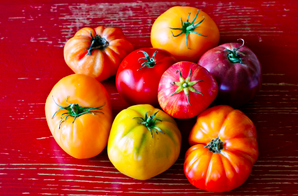
Long Live Veggies! – Extend the Life of Your Produce
By Jamin Mendelsohn
One of the biggest challenges of Rebooting can be procuring enough produce. It can be tough to fit in lots of grocery trips, and is definitely frustrating when your veggies go bad before you use them. Hey, no one likes a floppy carrot or a wilted kale leaf!
Shop farmers markets when possible – These vegetables are some of the freshest you can find. They haven’t spent time being washed in a factory, or shipped on a truck across the country, this time saved can translate into longer shelf-life for the end-user.
Look into a CSA (www.localharvest.org) – Community Supported Agriculture (CSA) is another way for people to buy local, seasonal food directly from a farmer – keeping the time between Picking and Eating to a minimum.
PRODUCE STORAGE
OUT OF THE FRIDGE (Cool, Dry Place, not Direct Sunlight):
Tomatoes, Potatoes, Winter Squashes, Onions, Garlic, Bananas, Stone Fruits (Peaches, Plums), Whole Pineapple
IN THE FRIDGE:
o Ripe Fruits – including Apples, Pears, Lemons, Berries and Grapes
o Root Veggies – like Carrots, Beets, Radishes — Trim the greens off before storing — The greens tend to pull the moisture from the root causing them to wilt prematurely.
o Leafy Greens and Herbs – Wash and Pat Dry (or use a Salad Spinner), then wrap in a damp paper towel and refrigerate in an open-ended bag.
o Eggplant and Mushrooms — Keep inside a paper bag
o Most other vegetables can be kept in plastic bags or in the vegetable drawer aka Crisper , including: Broccoli, Bell Peppers, Cucumbers, Fennel, Scallions, Cauliflower, Celery, Brussels Sprouts, Summer Squashes and Ginger.
For more vegetable-specific storage guidelines, visit https://www.fruitsandveggiesmorematters.org and type the veggie-in-question right into the search field!